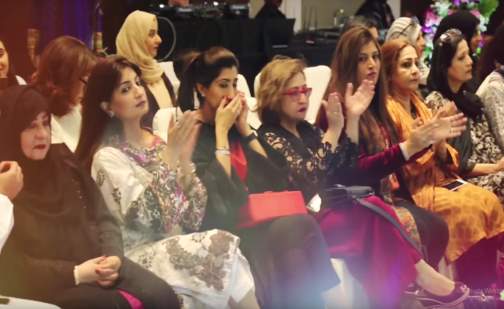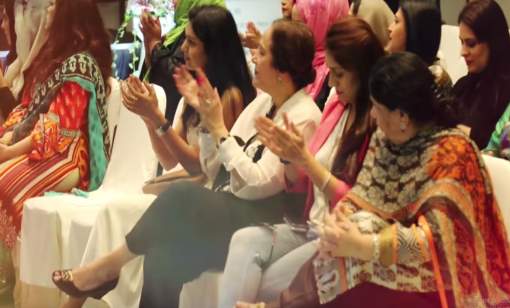Intersections in Fashion and Architecture: How Does a Designer Use Spatial Tools to Conceptualise the Runway Show of Their Collection?
Info: 11713 words (47 pages) Dissertation
Published: 10th Dec 2019
Tagged: ArchitectureFashion
The framework of the study enquires about the relationship Fashion and Architecture share, today. The manifestation of this relationship has been studied about in the context of Fashion Runway shows today and the role Architecture plays in designing the space where the event will occur. Interviews with Specialists, i.e. Runway designers have been conducted to gain a deeper insight into the Paradigm of spatial design factors determining the favourable outcome and/or success of a typical runway show. The follow up has been done through a site visit made after careful consideration of factors influencing the scope, limitations and parameters of study.
Parameters of Venue, Spatial Enclosure, Ramp Design, Lighting, Music, Backdrop design form the Tangible Design factors. While Audience and Timings of show form the Intangible Design factors of the show. Planning of all these factors in unison by a number of specialists is what determines the successful show.
The designers chosen for the study are Rajdeep Ranawat and Ritu Kumar since they both belong to the Indian Context. Two shows by Rajdeep have been chosen for an internal comparison with one show by Ritu Kumar to note the different peculiarities in the designing styles of designers in comparison to each other as well.
Additionally, Ramp designer Interviews have been conducted in the N.I.F.T. Campus to bring to light any factors which may have been overlooked due to insufficient knowledge.
Contents
2.1 EXIBHIT DESIGN – THE NASCENT STAGE OF RUNWAY SHOWS
2.2 INTERNAL COMPONENTS OF A RUNWAY SHOW
2.3 EXTERNAL COMPONENTS OF A RUNWAY SHOW
2.5 IMPACT OF WHERE THE SPACE IS / HOW IT IS PLANNED:
2.7 DURATION OF THE SHOW AND SHOW PROGRESSION
4.1.1 ”Collage Fashion show’’ by Rajdeep Ranawat
4.2.1 Asian Designer week 2017 – Rajdeep Ranawat
4.2.2 RAJASTHAN HERITAGE WEEK 2015 – Ritu Kumar
Part 5.1: Venue and the Spatial Enclosure
Part 5.4: Audience and Timings
LIST OF ILLUSTRATIONS
1. COVER PAGE (Alamy Stock image)
2. RESEARCH METHODOLOGY (Author)
PLATE 2.3.1 Marc Jacobs –The Fashion Designer
PLATE 2.5.1 Givenchy Spring 2016 – Roof top Venue
PLATE 2.5.2 Tommy Hilfiger Spring 2016 – Abandoned Warehouse transformed as per theme
PLATE 2.5.3 London Fashion week 2016 Backdrop design for space transformation as per collection theme
PLATE 2.5.4: Chanel Haute Couture Spring 2006 – using an architectural element in the ramp design to enhance show
PLATE 4.1.1 The Designer’s Logo
PLATE 4.1.2 The Designer
PLATE 4.1.3 Designer Sketches 1
PLATE 4.1.4 Sketched Designs
PLATE 4.1.5 Space within the venue used by designer for selling collections
PLATE 4.1.6 Schematic Planning of the space planning
PLATE 4.1.7 The Ramp Setup – Beginning of show
PLATE 4.1.8 Models arriving to the show
PLATE 4.1.8 The announcement of the show: Change of collection
PLATE 4.1.9 The conclusion of show
PLATE 4.1.10 Audience to left of the ramp
PLATE 4.1.11 Audience to the right of the ramp
PLATE 4.1.12 The models cat-walking around the market
PLATE 4.1.13 The models posing coyly for the camera
PLATE 4.2.1.1 Opening ambience of the show
PLATE 4.2.1.2 Onset of the show
PLATE 4.2.1.3 The Big Reveal
PLATE 4.2.1.4 The Lighting gradually increases
PLATE 4.2.1.6 Choreography is done zigzag to cater to VIP guests
PLATE 4.2.1.5 The final level of lighting
PLATE 4.2.1.7 The collection reimagines the scenery on the backdrop
PLATE 4.2.1.8 Conclusion of the show: Designer & Show stopper
PLATE 4.2.1.9 Schematic Approximate of the Runway show
PLATE 4.2.2.1 The Show begins with a lights out atmosphere
PLATE 4.2.2.2 The show opening model, bathed in warm light
PLATE 4.2.2.3 The show opening model, bathed in warm light
PLATE 4.2.2.4 Full view of the Runway show space
PLATE 4.2.2.5 The conclusion of the show
PLATE 4.2.2.5 Approximate schematic planning of the show
LIST OF TABLES AND GRAPHS
PLATE 5.1.1 Venue and Spatial Enclosure comparison chart
PLATE 5.2.1 Ramp and Lighting comparison chart
PLATE 5.3.1 Music and Backdrop comparison chart
PLATE 5.4.1 Audience and Timings comparison chart
1 INTRODUCTION
1.1 TOPIC
The rise of fashion is associated with “the civilizing process” in Europe. The medieval woman engaged in what became the feminine pursuits of weaving, textile work, and fashion. Fashion in medieval society had a direct impact on the emerging of the individual, on self-knowledge, and understanding one’s place in the world (Breward,). The body provided a principal means of expression through clothing; for example, to throw down one’s glove was an act of defiance that committed a person to certain actions. The deliberate manipulation of the social meanings attached to clothing helped initiate a heightened sense of the significance of fashion.
Though fashion was first created for the privileged few, in the late nineteenth and twentieth century mass production made fashion accessible to the majority. In the nineteenth century the distinguishing feature of fashion was its imposition of an overall standard that nevertheless left room for the display of personal taste. Fashion change accelerated with major apparel changes occurring in twenty-year intervals.
The fashion magazine and the Hollywood film brought fashionable models to a hugely expanded audience from the 1920s onward. Examples of fashionable dress were often made available through the expansion of chain stores and mail-order companies. At the same time, a reorganization of business practices, of marketing and advertising, prioritized certain strands of society as fashion leaders. A cult of the designer, revolving around ideals of couture and high fashion or strong subcultural identities, ensured the survival of hierarchies based on notions of quality, style, and individuality (Breward,).
The insights of design process relationships between the two fields of design with the use of their creative licenses to make things of great value to humanity. The commonalities of design between the two fields and talks about how both are the fields are the truest amalgamation of Art and Science owing to their requirement of being aesthetically pleasing… A quality derived from Art and yet being of some functional need of the user thus inculcating the touch of Science. In-depth understanding of the user (the client), the arts of Anthropometry and Ergonomics is essential in both the fields…
However, an Architect aspires to retain the position of a generalist to branch into different streams to draw inspiration from into her/his work to make it appear all the more Avant-garde.
This brief history of the importance of fashion, the correlations between architecture and fashion leads us up to the question of how the relationship has between the two worlds evolved, and what is the most robust modern relationship which they now share, in today’s day and age?
1.2 RESEARCH QUESTION
“How does a designer use spatial tools to conceptualise the exhibition (Runway Show) of their Artworks (Collection)?”
1.3 AIM
Aiming to explore the intersection of fashion and architecture through the new perspective of looking at Runway shows as the spatial design of moving exhibitions,
(Keywords: Spatial design, Moving Exhibits, Runway show)
1.4 OBJECTIVES
To investigate:
- How the designer piques the interest of the visitors not only by the means of their collection, its theme but also by designing the space they are exhibited in as well.
- How tools of spatial design can be used in conjunction to create similar spaces in different places with varying configurations. The planning of the space for smooth execution of the show.
- The impact of the enclosure of a space in the design of the runway, other factors such as lighting, ambience created, which determine the mood created and the overall success of the show.
1.5 SCOPE
- Runway shows will be considered the most relevant intersection of Fashion and Architecture.
- Indian Context has been chosen for primary case studies
- Only Single Designer – Runway shows will be relevant.
- Apparel Fashion for Women only will be considered.
1.6 LIMITATIONS
- Impact of social media/ celebrity appearances on success of a runway show not taken into account
- Budget constraints will not be taken into account
- Constrained sample size for case studies (most fashion shows in the vicinity are multiple designer shows)
- Inability to travel to different destinations for comparison between different shows by same designer.
- Photography limitations on sites of Primary Studies
- Inaccessibility to certain spaces of study during event (green room, backstage)
- The time provided to conduct research work and study was limited.
1.7 RESEARCH METHOD
The parameters that form the basis for the Primary Case studies have been identified from the Literature Review, Secondary Case Studies and Preliminary visits to N.I.F.T. Campus, Delhi. The research methods involved are primarily quantitative methods.
Primary case study: Interviews: Using a purposeful sample (runway designers) using an open ended Qualitative Questionnaire (ref. Appendix) Site visit: Following determination of parameters, analysis done by using observation, sketching and photography.
Secondary case study: Determination of Case study: Keeping in mind the scope and context of study, carefully determined case studies.
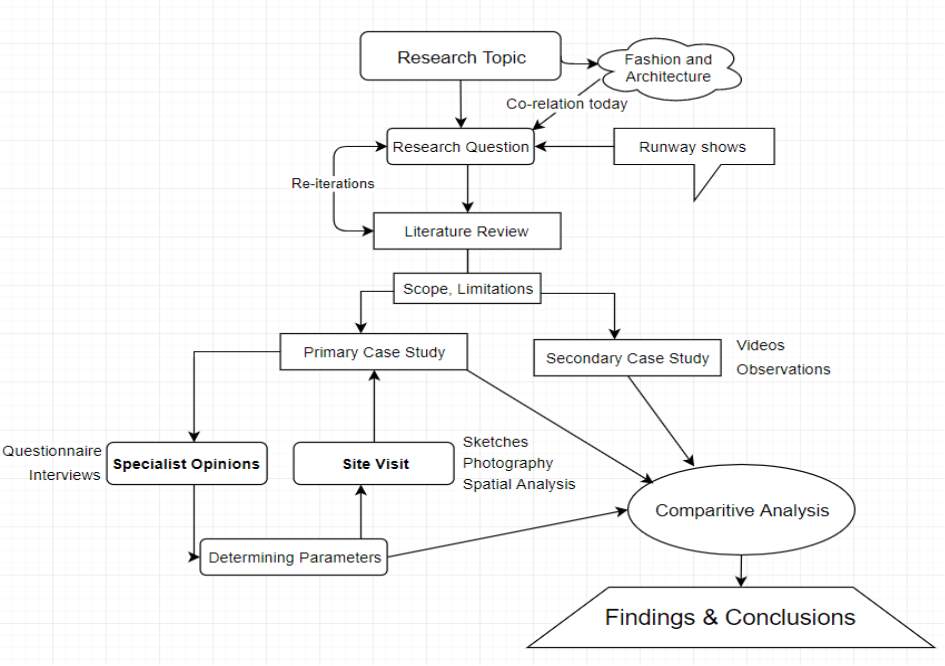 1.8 RESEARCH METHODOLOGY
1.8 RESEARCH METHODOLOGY
2. LITERATURE REVIEW
2.1 EXIBHIT DESIGN – THE NASCENT STAGE OF RUNWAY SHOWS
Exhibit design (or exhibition design) is the process of developing an exhibit—from a concept through to a physical, three-dimensional exhibition while serving the purpose of displaying the artworks. There exist many types of exhibitions such as Museums, Zoos, and so on. The idea behind effective Exhibition Design is the story that the exhibits whether collectively or individually convey to the visitor. It is interesting to note how the mutual relationship between the exhibitor – exhibition, and the visitor – exhibition forms an indirect relationship between the individuals of the exhibitor and the visitors.
Fashion shows in their nascent stages, were actually displayed on dolls or mannequins as exhibits to display the designs, which essentially makes it a traditional exhibition.
The discussion on the background and development of Fashion show and producing it occurred mostly as an event – to sell merchandise. European fashion shows have set forth a new era for innovation and theatrical presentations. The distinctive styles of the French, Italian, British, and American retailers and designers—couture and ready-to-wear—are discussed in this chapter along with emerging fashion-conscious countries, such as Canada, Brazil, Denmark, Spain, and so on.
2.2 INTERNAL COMPONENTS OF A RUNWAY SHOW
First, the components of fashion show are generally viewed to be four factors:
The program, the direction, the model, the sets
Second, it is shown to us that the most influential factor for the perception is
‘The directing’: (stage scenery, background music, lighting, effects etc.),
And ‘the sets’: (convenience seat, display, service facilities etc.).
So, in order to raise the level of satisfaction for the spectators, it is advisable to concentrate on these two main factors. Grouping merchandise in a creative and interesting line-up that fits the theme is also part of this activity.
Models, who display the merchandise on the catwalk, play an important feature of the show. There are advantages of and the differences between using professional or amateur models in a fashion show and the responsibilities of all the models during the fittings, rehearsal, and show.
The vivid opening, pace, and finale for the models Distinct patterns for runways, seating arrangements, and the appropriate use of lighting and props are feature is put forward by the Choreography of the show. Music has also taken centre stage in fashion show production. Show planners and the audience are aware that the music can enhance or detract from the atmosphere of a show more than almost any other theatrical element.
2.3 EXTERNAL COMPONENTS OF A RUNWAY SHOW
Other “outside” factors determining the show are:
• Audience formation and demographic characteristics
• Establishing date, time, and the fashion show venue
• The definition and use of a fashion show theme and scene themes
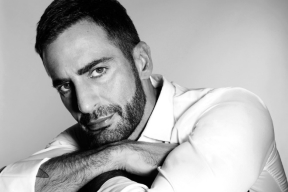 As an example, consider the planning process for the Marc Jacobs show, which begins with the designer’s inspiration for the collection . Then it takes an army of professionals with military-like scheduling to bring this event from planning to reality. Although Runway shows are extremely fun events, there is much planning, various kinds of experts which are required to bring the vision of the designer to reality, a lot like architectural projects.
As an example, consider the planning process for the Marc Jacobs show, which begins with the designer’s inspiration for the collection . Then it takes an army of professionals with military-like scheduling to bring this event from planning to reality. Although Runway shows are extremely fun events, there is much planning, various kinds of experts which are required to bring the vision of the designer to reality, a lot like architectural projects.
Intimidated through an Interview, before heading onto the runway, the models are presented in groups of 10 to Marc for final adjustments, to ensure the impact on the audience is made.
PLATE 2.3.1: Marc Jacobs –The Fashion Designer
All of these efforts go into creating a spectacle that looks inspirational and effortless to the anxiously awaiting audience. Months of preparation, planning and activities convolute into the final show which typically lasts 9½- 12 minutes.
One of the most important experts includes, the Stylist. Who must understand the designer’s target audience and help to interpret the look with attention to detail, appropriate-ate model fit, and use of suitable accessories. Stylists also work on
- the garment order (which can directly be correlated to an order of exhibits in an exhibition)
- which individual garments are coordinated to form an outfit (display of smaller artworks, say on a wall with a certain type of lighting),
- Strongly influencing the overall impact of the merchandise (The mood set/ ambience created for the visitors).
These fine details give the collection its feel, from classy to sexy or formal to casual.
2.4 FINDING THE VENUE
Once the date is established, where to hold the show is considered. This is called the venue, or the location where the show will take place There are many options to consider Will you hold the show in a hotel, restaurant, or school auditorium? On the retail sales floor? In the manufacturer’s showroom? Is your choice available? The stage manager and members of the stage committee determine the location keeping in mind the context and one of the essential things is that the dates picked for the venue may not clash with the dates for another show because that would in turn mean, a chunk of the audience may be unavailable to attend on the day of the show.
Who decides the Space?
Fashion show and special event production plays a major role in the job of Fashion director. Most shows require the services of a Stage manager who oversees use of the venue. The venue includes the front of the house, which involves the stage, runway, and seating. The stage manager also organizes equipment and supervises people providing services behind the scenes, such as the properties manager, stagehands, and audio and lighting technicians. The stage manager also supervises any announcers and verbal communication presented at the show. Some facilities, such as city auditoriums, have a stage manager on their staff and may require that they be hired by the group when the venue is rented.
2.5 IMPACT OF WHERE THE SPACE IS / HOW IT IS PLANNED:
Sometimes there are designers who insist on certain locations of venues for a certain kind of collection. Some examples are:
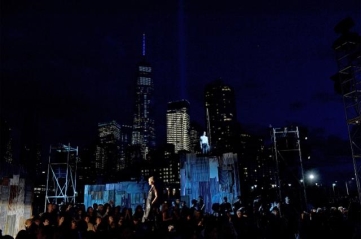 Givenchy Spring 2016 during New York Fashion Week Pier 26 at Hudson River Park on September 11, 2015 in New York City
Givenchy Spring 2016 during New York Fashion Week Pier 26 at Hudson River Park on September 11, 2015 in New York City
Guests watched as a Tibetan monk appeared on the Hudson River Pier 26 in Tribeca, a setting that staged a glorious runway show with the World Trade Centre’s Freedom Tower glistening in the background. The monk’s chants signified the kick-off of Givenchy’s fashionably late New York Fashion Week show. Tisci teamed up with artist Marina Abramovic to create a contemplative spectacle that paid tribute to the losses on 9/11 and served as a reminder to slow down, reflect and be present. This show created a lot of controversy while it was in the planning stage but after the show it was an effort well appreciated by the media and public alike. This serves as an example of possibly how the location with a significant event whether pleasant or unpleasant can make a drastic impact on a runway show.
PLATE 2.5.1: Givenchy Spring 2016 – Roof top Venue
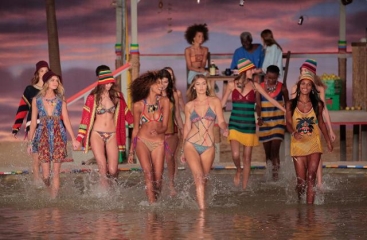 Tommy Hilfiger Women’s Spring 2016 during New York Fashion Week
Tommy Hilfiger Women’s Spring 2016 during New York Fashion Week
The Hilfiger team transformed a bare NYC warehouse into a tropical setting, which ultimately transported attendees into Tommy’s vision of the beach chic line. The backdrop consisted of an Instagram-worthy view with a sandy island, towering palm trees, a beautiful sunset, a straw roofed wooden bar, and twinkling lights to pull it all together. The catwalk resembled a beachside boardwalk that wound around an ankle-deep pool of water. This runway show is an example of a vision which transformed an enclosed space into a seemingly open space due to its theme being along the lines of a beach which an individual generally associates with a fun-filled time, a sun setting in the horizon, the calming sound of waves hitting the seashore.
PLATE 2.5.2: Tommy Hilfiger Spring 2016 – Abandoned Warehouse transformed as per theme
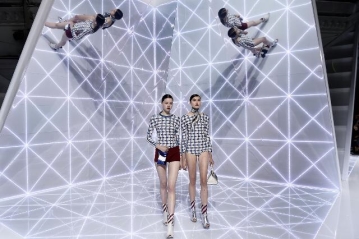 London Fashion Week Spring/Summer 2016 on September 22 2015
London Fashion Week Spring/Summer 2016 on September 22 2015
Anya Hindmarch brought her guests back to the days of being a child with her take on a fun house-themed runway. Anya showed her collection on the last day of London Fashion Week, which closed the week of fashion-filled glamour with an origami puzzle of mirrors that acted as a backdrop to create a confusing kaleidoscope view of her collection. If the mirrored alcoves, weren’t enough to create a memorable show, the models’ simple outfits and synchronized movements left guests feeling as if they had just stepped into the future. Here the designer has used the tools of lighting and mirrors to create optical illusions to set the audience into a “futuristic” outlook mood.
PLATE 2.5.3: London Fashion week 2016 Backdrop design for space transformation as per collection theme
The visitors were seated such that the backdrop looked like the model had a doppelganger awaiting in the opposite direction than the model. Having some parts of the runway light up as guides reflecting into the mirrors provided a heightened feeling of aerial suspension.
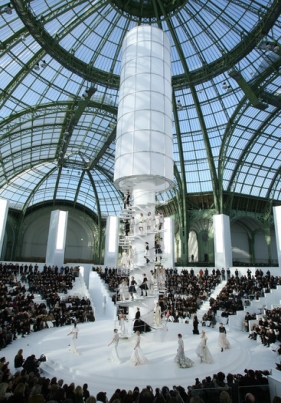 Chanel Haute Couture Spring/Summer 2006
Chanel Haute Couture Spring/Summer 2006
Karl Lagerfeld keeps alive the spirit of Chanel years after her death by continually experimenting not only with the apparel designs but with the manner they are presented to the visitors. He holds nothing back while designing an exquisite experience for all the VIP guests who watched as one by one the models emerged from the mysterious top of the centrally placed spiral staircase. Everyone sitting around got glimpses and small peeks of models elegantly strolling down the steps enticing curiosity.
The X-factor of this show was the bold move of the designer putting a huge spiral staircase in the centre of a circular runway, and dramatic impact of all the models glimpsing the designs as the walk down the staircase and walk the ramp in a circular choreography and then finally existing through a tangential pathway laid between a strategic seating of guests.
This design allowed for the ultimate build-up of sorts, where giving information to the viewer in small doses accumulates a manner of suspense and interest for the viewer.
PLATE 2.5.4: Chanel Haute Couture Spring 2006 – using an architectural element in the ramp design to enhance show
Is there a specific date when the show
2.6 AUDIENCE FORMULATION
Type of audience
Fashion shows are generally more successful when they are promoted to a specific audience, rather than to the general public. The size, age, gender, income, and occupation of the targeted audience must be appraised. Other considerations are the interests and lifestyles of the audience, and the occasion and/or season for which the show is being held. The size of the audience often determines the type of show, although sometimes the type of show can determine the size of the audience. All members of the audience need to be able to easily view the fashions from a comfort-able location.
Audience impact on the type of Venue
A production or runway show may be required if the audience is large, fill-in a
2.7 DURATION OF THE SHOW AND SHOW PROGRESSION
Some fashion week shows last less than 10 minutes, because that is the stipulated time limit the designer requires to make the required impact on the targeted audiences. While others last much longer depending on the arrival of celebrities, critics, allowing interviews of celebrities for publicity purposes and so on.
Usually all Fashion shows begin with the turning down of lights and some announcements. During this time the backdrop of the stage may or may not be lit. Lighting up the backdrop later is used as a strategy by designers to focus the viewers’ attention as in when the show starts. The music may or may not be playing depending on theme, mostly. Smoke a commonly used tool to create a sense of mystery and glorify the beginning of a show. The first model emerges; this must usually have the most dramatic impact to hold the attention of the audience throughout the show. The lighting and music changes as in when required to create a desired impact. The show mostly concludes with the model (typically a celebrity or a show stopper) walking the ramp with the designer(s) and as they stand in the front the other models collect behind them forming the new back drop.
3 RESEARCH METHODOLOGY
Since the crux of the journal will be spatial designing to pertain the character of the same exhibition as the enclosure, amount of space available changes, hence redesigning of crucial elements such as the ramp will change. This in turn will imply the planning of movement of exhibits will change. To completely understand the impact of these valuable decisions.
Research Methodology will include adding to the body of knowledge by:
- Acquiring relevant theory about adjoining fields and topics such as,
Procedure and Planning of a Fashion show
Understanding components of a Fashion show
Spatial characteristics of shows
Theory between an Exhibitor and an Exhibition
Theatrical Performance spaces
Event Design
Set Designing
- Past runway shows (Secondary case studies)
Fashion designers who set the trend of designing the space of their collection reveals and how they adapted to different locations or significance of the visitors visiting their shows. The Case study will be performed by watching the runway show’s telecast.
- Runway Shows Visited and Specialist interviews (Primary case studies)
Fashion shows visited to conduct Case studies, additionally, interviews with fashion show designers also taken to provide valuable insights into the topic and to cover any factors if missed.
Interviews with people who work in the creative team of Fashion designers to determine the spatial designs:
- Dr. Purva Khurana,
Runway show Designer, Faculty of Apparel department, N.I.F.T. (National Institute of Fashion Technology, Delhi)
- Dr. Monica Gupta,
Runway show Designer, Faculty of Textile department, N.I.F.T. (National Institute of Fashion Technology, Delhi)
3.1 PARAMETERS FOR ANALYSIS
Based on parameters determined after the literature review, the following is the analysis:
1 Venue is decided baring significance to the kind of collection, intention and the targeted audience. An example would be my case study – ‘Collage Fashion show’ by Rajdeep Ranawat which had the targeted audience as per the location i.e. DLF Place, Saket. This place is typically characterised by visitors who are fairly wealthy, and have a considerable purchasing capacity.
2 Spatial Enclosure can be further split into two factors as well:
- Open Arena (open to sky)
Having an open to sky location typically means the spaces must be planned from scratch, audience locations, seating arrangements, stage arrangements must be all planned.
Other factors to be kept in mind are timings of the day, weather, and climate and so on.
- A closed space (typically a hall)
An enclosed space usually is a space which pre-determined stage, audience seating, entry and exit points, green rooms etc. this can sometimes save time or act as a hindrance for a designer. Other influencing factors maybe the stepped seating, size of stage
3 Ramp designs are a cyclic process, which concerns itself with the “change” time, number of designs to display, number of models available. These together determine the choreography of a walk, which is in turn decided by the location(s) of the audience.
4 Lighting is planned similarly. It is kept crisp white if the show intends to sell the products to the audience, to display the correct iwocolours of the garment. However sometimes the designer givens higher priority to “setting” of the mood. This is a designer’s weprerogative.
5 Music is usually planned so as to match the rhythm of the model’s walk on the ramp. If big, fast strides are to be taken, then RTmusic is peppy and fast paced, if slow, small steps are to be taken then music is usually toned down.
6 Backdrop designs are kept either as a black or a white screen which (if budget allows) has things projected on them. In larger WEfashion shows they place life size monitors and change the visuals on them as per the design /mood.
7 Audience can be further split into two factors:
- The type/kind of Audiences
As discussed in the literature review at length, the targeted audience the demographics of the audience and the intention behind invitations is a crucial aspect.
- The location of the Audiences
The viewing angles, line of sight is what typically determines the location of the audiences and their seating.
Sometimes factors may include the type of garment and others as such.
8 Timings either as play an important role to facilitate the arrival time and comfort of the audience. Typically, late evenings are the QWmost preferred time however some prefer mornings as well to ensure the audience is not tired after a day’s work but fresh to enjoy RT the show.
4 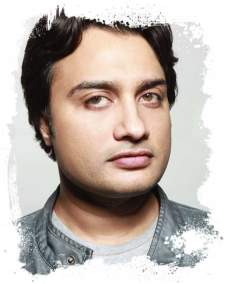 CASE STUDIES
CASE STUDIES
4.1 PRIMARY CASE STUDY
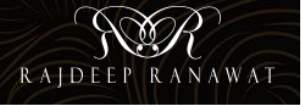 4.1.1 ”Collage Fashion show’’ by Rajdeep Ranawat
4.1.1 ”Collage Fashion show’’ by Rajdeep Ranawat
Visited on: Sat, 7 Oct 7:30PM DLF Place, Saket, New Delhi
PLATE 4.1.1: The Designer’s Logo
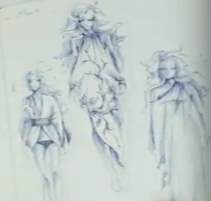 About the Designer:
About the Designer:
PLATE 4.1.2: The Designer
“Rajdeep Ranawat” is an Indian fashion label, founded by its namesake couturier Rajdeep Ranawat
in Oct 2004. The label draws its direct inspiration from nature and specialises in luxury goods like
haute couture, pret-a-porter, resort-wear, diffusion, among others; for both the sexes.
Creating apparel that are best described as “art to wear” the label strives to incorporate high class elegance and originality to practical designs.
At
PLATE 4.1.3: Designer Sketches 1
Reason for choosing this event as my Primary Case study:
Rajdeep‘s show was the only possible Single Designer Runway Show which was well within my
geographical reach and was well within the scope of my dissertation.
PLATE 4.1.4: Sketched Designs
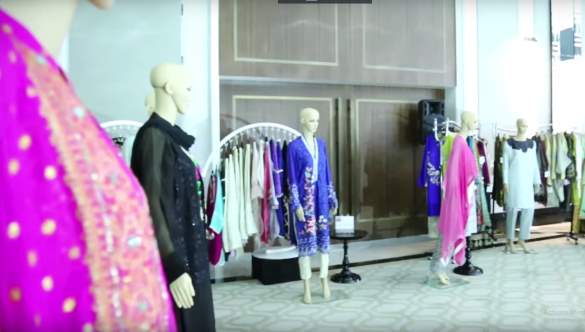

PLATE 4.1.5: Space within the venue used by designer for selling collections
PLATE 4.1.6: Schematic Planning of the space planning
The exact location of the event was not within the shopping mall as I expected, but at building behind the mall. There was ample parking in front of it. Some fancy cars seemed to have been parked. Entry was by invitation only, which were available at this office. No restrictions on children, families were welcome. The audience primarily seemed to be women. After entering the lobby, I was guided inside by one of the receptionists.
I walked into a small market like thing set up, displaying his various designs. Some on mannequins some on clothing racks, it was clear that he hopes to sell his some of his collections after/before the show. At 7:20 pm we were all seated and the announcer made some announcements.
The space I entered next was a multipurpose hall, about 15 x 20 metres in dimension. With the Ramp at the far back end.
The ramp was a T shaped ramp, abutting two large projectable screens a basic panel with the name of the show and the designer was placed.
There was not much noticeable change in the lighting as the show began. Two models started the show by entering on either sides of the “T shaped ramp”. The choreography was rather simple, models posed near the backdrop and at the end of the ramp.
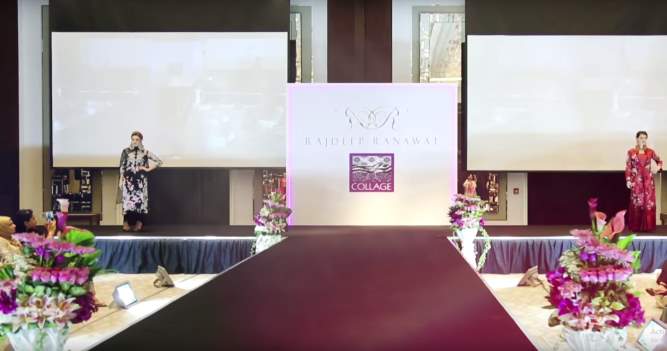

PLATE 4.1.7: The Ramp Setup – Beginning of show
PLATE 4.1.8: Models arriving to the show
The ramp was about 2 metres wide with, a height of about 0.8 – 1 metre, decorated scarcely, by a total of 6 ornamented vases at the intersection Points of the ramp. The show began with the onset of some moderately peppy music, which the audience seemed to enjoy. The models strolled to the centre, posed and walked forward, one after the other, posed again at the bottom of the T-ramp and walked back.
The Music changed to more indie tunes as the collection changed from bridal wear to traditional salwar kurta with a fashionable twist:
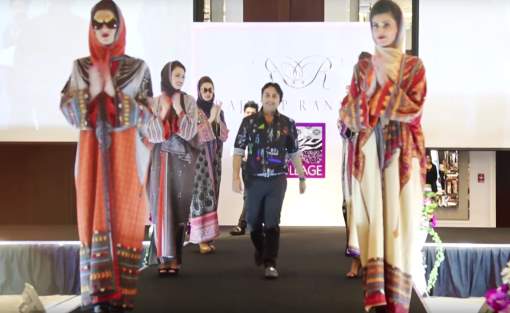
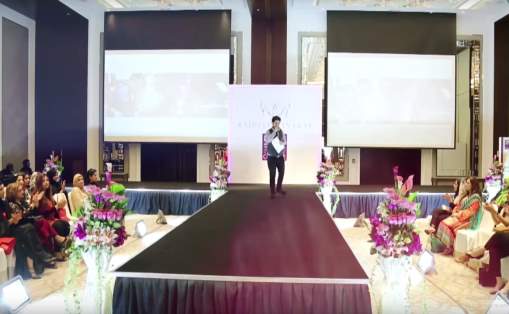
PLATE 4.1.8: The announcement of the show: Change of collection
PLATE 4.1.9: The conclusion of show
Noticeably, the seating and eye level of the audience was lower than general. This was possible because there were no dresses with
Any underskirts. The arrangements made for the show were all subtle, where in the focus was mostly on the designs, with the minimal floral decorations putting forth the designer’s intention of “being inspired by nature for his designs”.
The show lasted for approximately 9-10 minutes concluding with the designer walking the ramp and giving a brief speech about his current collection and what inspired him to come up with it, the hurdles he faced and how contented he feels by his work.
The Audience:
Mostly the audience seemed to be women of about 25-50 years of age. Upon talking to one of the audience present I found she was here to buy a dress for her newly wed daughter-in-law. Hence she came here with a few of her kitty-party friends who decided to tag along to help her choose and to buy some dresses for themselves.
PLATE 4.1.11: Audience to the right of the ramp
PLATE 4.1.10: Audience to left of the ramp
There were a few families at the venue as well but they decided to be seated at the back to avoid any disturbances due to their children. The fathers appeared to be handling the children while the mothers watched the show. There were also some media personnel seated at the back who seemed to be awaiting an interview with the designer after the show. The designs seemed to cater to the women of the Muslim community as well with the colourful dupattas which could double up as classy hijabs for them. The number of people present was about 35 or so, including myself.
Interesting thing to observe:
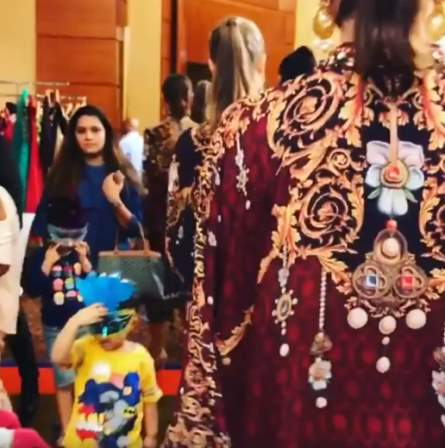
 After the show the models did a beautiful collective walk around the temporarily put together market space, everybody seemed to move out of their way as they walked.
After the show the models did a beautiful collective walk around the temporarily put together market space, everybody seemed to move out of their way as they walked.
PLATE 4.1.12: The models cat-walking around the market space
PLATE 4.1.13: The models posing coyly for the camera
They halted before a beautiful wall where the designer was waiting and they all did a collective pose as a photographer took some photos. The event seemed to be enjoyable for all, and he seemed to have made a fair amount of sales by the end of the day.
4.2 SECONDARY CASE STUDIES
4.2.1 Asian Designer week 2017 – Rajdeep Ranawat
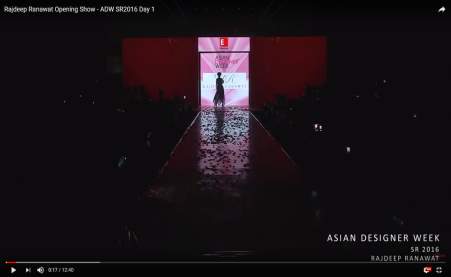
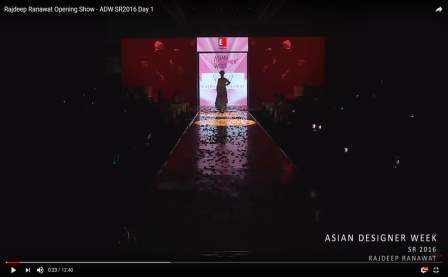
PLATE 4.2.1.2 : Onset of the show
PLATE 4.2.1.1: Opening ambience of the show

The show begins with a space with the lights out, and the backdrop lit up to draw focus of the audience as the silhouette of a women in a dress strolls to the centre of a patterned ramp littered with rose petals and poses, as she walks forward her walk is lit up with warm coloured spotlights. The music filling the space is that of a flute playing tunes symbolising calm laid back nature. The back drop design consists of 3 strategically placed screens, one as the ramp and of the sponsors and the other two adding a visual flavour to space, resembling a luxurious vacation, as envisioned by the designer.
PLATE 4.2.1.3: The Big Reveal
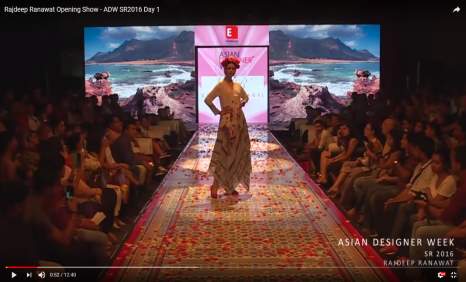
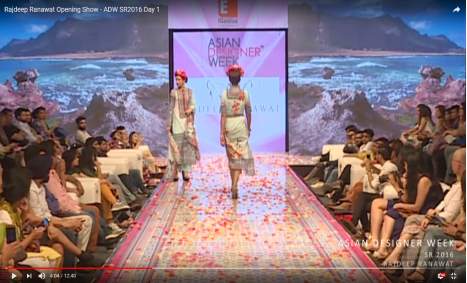
PLATE 4.2.1.6: Choreography is done zigzag to cater to VIP guests
PLATE 4.2.1.4: The Lighting gradually increases
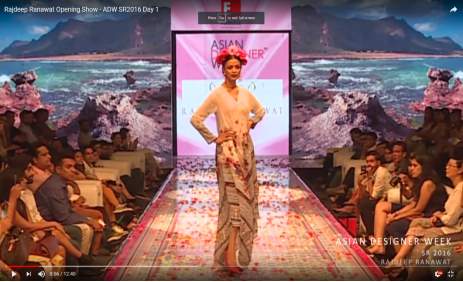
The show was about 12 minutes 30 seconds long. Upon change of type of clothing the lights went out again and came back on. Towards the end of the show the laid-back pace of the music quickened slightly as more number of models walked by until the show stopper arrived and the music slowed down a lot.
Within the Audience, there were exclusive white couches provided for the V.I.P guests, to whom the models exclusively paused for and catered to. The audience seems to be fairly mixed in terms of gender, age and economic class. The eye level of the audience was kept higher this time, perhaps to avoid underskirt views.
PLATE 4.2.1.5: The final level of lighting
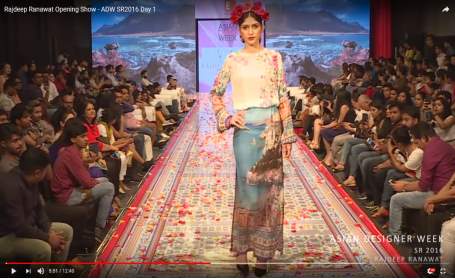

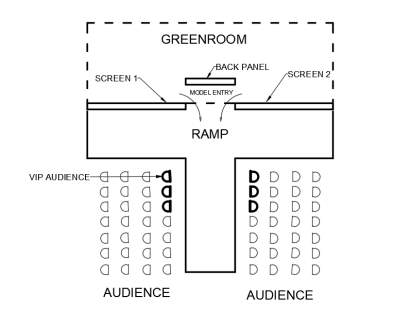
PLATE 4.2.1.7: The collection reimagines the scenery on the backdrop
PLATE 4.2.1.8: Conclusion of the show: Designer & Show stopper
Reasons for choosing this show for case study:
This show is most recent show done by the same designer, a runway show setup made exclusively for his show. It will help me to draw parity on what factors of a runway show a designer redesigns in lieu of change of location.
Designer’s intention:
With his Spring Summer 2016 collection titled “Escape to Italy,” Ranawat transported the attendees of Asian Designer Week in Delhi to the most beautiful coastal towns of Italy. Along with his muse, the supermodels, Ranawat presented looks that included stunning hand-painted artworks, architectural paintings of villas, islands, boats and pretty foliage, which were in turn inspired by the picturesque coastal cities of Portofino, Positano and Sorrento on the Amalfi Coast.
PLATE 4.2.1.9: Schematic Approximate of the Runway show
4.2.2 RAJASTHAN HERITAGE WEEK 2015 – Ritu Kumar
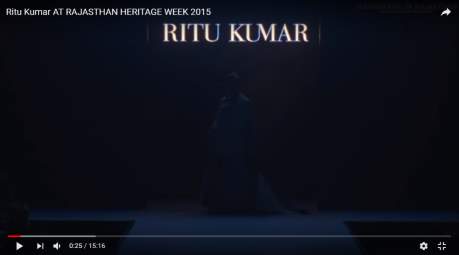

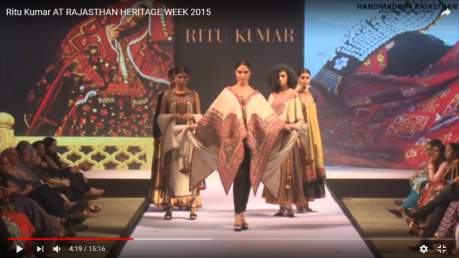
PLATE 4.2.2.1: The Show begins with a lights out atmosphere
PLATE 4.2.2.2: The show opening model, bathed in warm light
The show had a running time of about 15 minutes and 30 seconds, beginning with a lights out space with the name of the designer highlighted. The Indian folk music playing evoked a sense of pride associated with Indian traditions, Flexible and smart space design allowed for the backdrop to be completely subtle to draw focus to the apparels of the models. Similarly, the back drop can transform into scenes to compliment the designs to help create the overall mood. The Ramp chosen was a T-shape ramp with all the lighting designed overhead.
PLATE 4.2.2.3: The show opening model, bathed in warm light
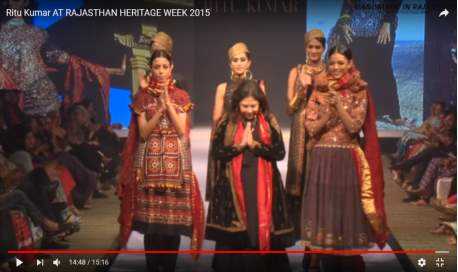
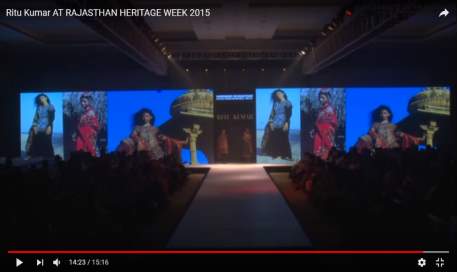
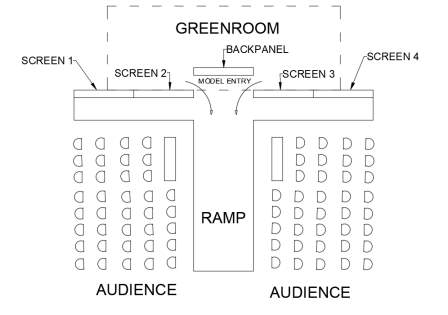
PLATE 4.2.2.4: Full view of the Runway show space
PLATE 4.2.2.5: The conclusion of the show
Reasons for choosing this show for case study:
The setup of the show is a fresh variation in terms of backdrop design, with a designer within the Indian context to conduct a comparative analysis. Also, it was the only show available with a wider angle view of the full runway show setup.
Designer’s intention:
The aim of the designer was to present a unique initiative to position the textiles of Rajasthan as luxury handmade products, working with the finest Indian designers and artisans and weavers to enhance their careers. Giving them an opportunity to expand the horizons of their businesses.
PLATE 4.2.2.5: Approximate schematic planning of the show
5 COMPARATIVE ANALYSIS
Comparing the compiled data for all the case studies, the comparative analysis can be further broken down into four parts:
Part 5.1: Venue and the Spatial Enclosure
The relevance of the Venue or location can be subdivided into Importance of the Destination with respect to the collection or designer (Givenchy Spring 2016 in the Literature review) to evoke a certain type of emotion/ reaction from the audience. And the Type of Audience the show wishes to cater to, something akin to the reputation of a certain area being an expensive location or a highly commercial location:
Whereas Spatial Enclosure (as previously discussed) subdividing into an Enclosed space or an Open Arena
| SHOW & DESIGNER | VENUE | SPATIAL ENCLOSURE |
| COLLAGE FASHION SHOW – RANDEEP RANAWAT | DLF SAKET, DELHI | ENCLOSED |
| ASIAN DESIGNER WEEK 2017 – RAJDEEP RANAWAT | GARDEN OF SENSES, DELHI | OPEN ARENA |
| RAJASTHAN HERITAGE WEEK 2015 – RITU KUMAR | CLARKS AMER, JAIPUR | ENCLOSED |
PLATE 5.1.1: Venue and Spatial Enclosure comparison chart
In the Collage Fashion show, Rajdeep tries to attract a certain economic sect of people, by locating the show in one of the most visited spots by the Elite Delhi-ites. The show had an extremely temporary setup in a multipurpose hall, which he possibly held only to boost sales/ advertise himself to select number of people. However, in the Asian designer week and Rajasthan Heritage week, there have been people who are especially associated with Fashion design. The location of the Asian Designer week, Garden of five senses has bearing over the designer being inspired by nature for his designs. Similarly, at a larger scale, for Rajasthan Heritage week being held in Jaipur, a city famous for Indian traditions.
The Spatial Enclosure in case of Enclosed does not have a heavy impact because the seating is not fixed in any case study. The Open arena had a minimal impact because perhaps because of the weather, the space was not open to sky.
Part 5.2: Ramp and Lighting
The Ramp sizes, length and turns typically are relevant in aspects of Number of models versus Number of Designs. Choreography of the walk also plays an important role for the change time required for the models.
Lighting is relevant to direct the viewer’s eye to certain models, or certain important aspects of the design. And in a wider sense to create and supplement the mood of the collection for the Audience.
| SHOW & DESIGNER | RAMP | LIGHTING |
| COLLAGE FASHION SHOW – RAJDEEP RANAWAT | T- SHAPED RAMP | OVER ALL LIT + BELOW RAMP + WARM LIGHT |
| ASIAN DESIGNER WEEK 2017 – RAJDEEP RANAWAT | T- SHAPED RAMP | OVER ALL LIT + CEILING SPOT LIGHTS+ WARM LIGHT |
| RAJASTHAN HERITAGE WEEK 2015 – RITU KUMAR | I – SHAPED RAMP | OVER ALL LIT + CEILING LIGHTS+ WHITE LIGHT |
PLATE 5.2.1: Ramp and Lighting comparison chart
By conducting the case studies, a T-shape ramp seems to the widely adapted method of Ramp planning. Rajdeep typically tends to use the same kind of Ramps throughout his shows with a similar choreography, only variations being some stops near the VIP seating. The width of the Ramp is good enough for three people to walk together on it closely. In the Collage show it was about 2 metres in width. Ritu seems typically design a more linear movement, and does not end the show with all of the models collectively on display over the ramp, hence chooses an I-shaped ramp (using it in the manner of an I-shape even if a T-shaped ramp is provided)
For the lighting, all three shows seemed to have a similar beginning with a lights out atmosphere, thereby creating an impactful entry for the show opening model. Seemingly characteristic of each designer, Rajdeep tends to use a softer lighting with a warm yellowish glow while Ritu likes to use crisp white lighting. For the Collage Fashion Show, Rajdeep used a well light hall, with some light below the ramp. However, for the Asian Designer week he chose to have spotlights like Ritu. Interestingly, both chose to also have the lighting focus on the audience along with the show.
Part 5.3: Music and Backdrop
Music of a show is impactful in creating the right mood for the audience which helps them be a part of the designer’s intent while creating the collection and also provides the rhythm for the choreography of the walk for the models.
| SHOW & DESIGNER | MUSIC | BACKDROP |
| COLLAGE FASHION SHOW – RAJDEEP RANAWAT | PEPPY POP MUSIC | 2 PROJECTABLE SCREENS + BLANK WHITE BACK PANEL |
| ASIAN DESIGNER WEEK 2017 – RAJDEEP RANAWAT | SOOTHING TUNES ON THE FLUTE | 2 LED SCREENS + BLANK WHITE BACK PANEL |
| RAJASTHAN HERITAGE WEEK 2015 – RITU KUMAR | TRADITIONAL INDIAN FOLK MUSIC | 4 LED SCREENS + BLACK BACK PANEL+ NAME |
Backdrop Design determines the feeling conveyed by the atmosphere of the fashion show and the level of immersion for the audience in terms of visuals of the show apart from the collection. Apart from this intangible aspect the backdrop design also determines the entry and exit of the models on the Ramp.
PLATE 5.3.1: Music and Backdrop comparison chart
Rajdeep in the Collage Fashion show wished to convey the modernity of his collection to the Audience; therefore, the music reflected this with the choice of trending Billboard numbers which the audience could hum along. In the Asian Designer week, he chose soothing tunes played on the flute to transfer the audience into the relaxing lullaby of a luxurious vacation near the beach. Folklore music which evoked a sense of national pride linked with Indian traditions was the choice of Ritu Kumar, striking a resounding chord with the Indian audience.
The backdrop designs for both the designers seemed incomplete without screen projecting associated visuals. However, in the collage show, this did not have any impact due the lighting of the space, making the projection on the screens barely visible to the eye. The entry for the models was from the extreme sides of T-shaped ramp. In both the Asian week and The Heritage week however, the screen had a more profound impact. Also, for both these shows the entry was central from a gap between the screens and the back panel, guiding a linear choreography. Ritu Kumar had her name in glided letters over the back panel, because of her famous reputation.
Part 5.4: Audience and Timings
Audience of a show is planned and predefined by the designer depending on the aim of the show. Typically, a show is held either to boost sales or to promote the popularity of a designer. In certain other cases it is mostly held in conjecture to Model competitions. Therefore this determines the type of audience and their purpose with the show. Second, the Demographics of the audience, whether it is for a certain gender, economic class and so on. The Seating Plans deeply affect the line of sight of the audience and the views of the show.
Timings are a essential part of the show because it determines the availability of a certain type of audience and or the exclusivity of the event. Typically, shows are held in the evenings to broaden the availability of guests. Mornings and late nights are usually chosen when the event is planned exclusively for a set of people who can make it for the event owing to its speciality.
| SHOW & DESIGNER | AUDIENCE (TYPE + SEATING) | TIMINGS |
| COLLAGE FASHION SHOW – RAJDEEP RANAWAT | MOSTLY FEMALE + TEMPORARY SEATS | LATE EVENING , 7.30 PM |
| ASIAN DESIGNER WEEK 2017 – RAJDEEP RANAWAT | MIXED + VIP + TEMPORARY SEATS | EVENING, 5.30 PM |
| RAJASTHAN HERITAGE WEEK 2015 – RITU KUMAR | MIXED + TEMPORARY SEATS | MORNING , 11.00 AM |
PLATE 5.4.1: Audience and Timings comparison chart
The Collage Fashion show had an exclusive audience to cater to, the office going/social ladies and clothing for the bridal rituals. As per the theme of the Asian Designer week, the designer aims to attract audience who is planning an important holiday and wants to look their best on it. Perhaps these particularly important people are the VIP guests of the show in addition to the Critics present. Ritu Kumar’s collection caters typically to the Rajasthani Rajputana women or people who have a taste for the same.
The timings decided by both the designers’ displays the parity between their guest planning. Rajdeep typically keeps his shows in the evening and Ritu keeps them in the morning owing to the exclusivity of her shows.
6 FINDINGS AND CONCLUSIONS
“How does a designer use spatial tools to conceptualise the exhibition (Runway Show) of their Artworks (Collection)?”
After much in-depth study and analysis, the determining Parameters of conceptualisation in a Runway show design were found to be the following, with the implications of their respective impacts: –
• Venue and Spatial Enclosure:
Venue helps in deciding the type of audience. (Unless predefined by means of invites and such) It can also be used in conjecture with the theme of the collection to resound a deeper bond with the audience. Depending on the type of designer, some design a space beginning from the arrival, at the location, meticulously planning the journey whereas most only design the show space.
Designing a Runway show depends a fair amount on Spatial Enclosure as well. An Open-to-sky location would require a lot of preplanning not only in terms of show execution but also on environmental variables such as weather and climate. Enclosed space usually means pre-installed factors not much room for drastic change or design. In some cases, audience seating is also fixed as in case of auditoriums and such.
• Ramp and Lighting
The biggest determinant of Ramp designs is the ratio of number of designs to be showcased to the number of models available. Mostly number of designs is more which leads us to take into consideration the “change” time required by models to change outfits. Further becoming the guiding factor for changes in choreography of walks. The most commonly used Ramp shape is a “T” shaped ramp interchanged sometimes with an “I” shaped ramp, only in special cases are curvilinear ramps designed. T and I shape are the preferred norm due to easier availability of materials for the rectilinear shapes and avoid any mishaps with the ramp walk choreography.
Focus is mostly on the ramp and some light on the audience. To be more specific, there is more intense (task) light on the ramp and low intensity (ambient) light on the audience. Lighting colours often change or are switched off to enhance certain points in the show. Commonly, crisp white light is preferred because it brings out the colours of the garment to the most correct degree. Alternatively, some designers use a warm tinted light for a more relaxed mood of the audience.
• Music and Backdrop
As discussed in 5.3, music plays a crucial role in not only providing the acoustic brain stimuli for the audience for a more complete immersion into the theme of the show. It also determines the rhythm of the ramp walk for the models whether their gait should be long slow strides or quick small steps. Often, in detailed planning, the pauses in the music correspond with the poses of the model in the show. Usually the preferred music for shows are instrumentals to maintain the sobriety of the event, however sometimes designers prefer trending/ well known music pieces to titillate the audience. Striking the bond of familiarity becomes key in these cases.
Backdrop design has to mostly do with advertising and providing a background for photography/ show recordings. Usually there exists a back panel stating the shows name, sponsors, designer name while the adjoining screens display images relevant to the theme of the collection. The arrangement of the screens and the panels determines the entry points for the models onto the ramp. Central entry in-between from a crevice formed by the back panel and screens is the norm. Sometimes the entries are designed to be form the further edges of the screen, as in the case of T-shape ramp.
• Audience and Timings
At the designer’s discretion and intention behind the event the audience is formulated. This audience range varies from laymen public, to Fashion critics, from powerful media personnel to rich patrons. In certain cases, a paid audience is also required. Sometimes shows are about boosting sales, other times they are about broadening business connections and gaining publicity.
Show timings are a kind of shrouded secret key to success of a show. Timings through day, location determine whether the audience will be on time, have prior engagements. If not planned, the show may clash with another show leading to important guests who may not turn up for the event.
Planning a show requires a fair number specialists and creative people. It is quite the uphill task, but if planned meticulously, can be quite the breeze and have a desired successful output.
BIBLIOGRAPHY
- Books :
- Quinn, B.; (2005), The Fashion of Architecture, Berg Publishers, Oxford
- Pye David; (1964), the nature of design, London.
- Laver, J.; (1982), Costume and Fashion: a Concise History, Thames and Hudsons, London.
- LoschekIngrid; (2009) “When Clothes become Fashion, Design and Innovation systems”
- Blumer, H. (1969): “Fashion: From Class Differentiation to Collective Selection.” The Sociological Quarterly 10, no. 3 :275–291.
- Steele, V. (1998) Paris Fashion: A Cultural History. Rev. ed. Oxford: Berg.
- Breward, C. (1995) The Culture of Fashion. Manchester, U.K.: Manchester University Press,
- ipovetsky, G. (1994) The Empire of Fashion. Princeton, N.J.: Princeton University Press
- Everett, Swanson (2013), Guide to Producing a Fashion show, 3rd edition, Bloomsbury Publishing Inc.,
- Parker, Oren W & Wolf, Craig. (1997) Scenic Design and Stage Lighting. Harcourt Brace
- Adcock, Craig. (1990) James Turrell: The Art of Light and Space. University of California
- Ruthven, Peter & Burnett, Kate (eds.). (1999) Time + Space (Design for Performance and Alternative Spaces). S.B.T.D.
- Unpublished journals:
- Suthar Parul (2013), Fashion and Architecture, New Delhi -, S.P.A. Delhi, Dept. Of Architecture
- Bhaumik Rahul (2013), Fabric and Parametric Architecture, New Delhi -, S.P.A. Delhi, Dept. Of Architecture
- Aggarwal Tanuj (2009), Architects as Designers, New Delhi -, S.P.A. Delhi, Dept. Of Architecture
- Websites:
- Lakme Fashion Week Winter Festive- 2017
- Victoria’s Secret Fashion Show 2016 & 2015
https://www.victoriassecret.com/fashion-show/videos/
- DeLong Marilyn Revell (2012), Encyclopedia of Clothing and Fashion
COPYRIGHT 2005 The Gale Group, Inc.
http://www.encyclopedia.com/fashion/encyclopedias-almanacs-transcripts-and-maps/fashion-theories
Retrieved on 15th Aug 2017.
- http://www.designwithpurposeblog.com/culture-play (Interview happened on 6th August, 2012) retrieved September 6, 2013
- www.archinet.com/fashion%and%architecture%sept%08%2013 (Interview happened on 12th December) 2012, retrieved September 8, 2013
- http://www.sololisa.com/solo-lisa-2010 (Interview taken on Tuesday, June 15. 2010, by solo Lisa) retrieved October 11, 2013
- https://www.eventshigh.com/detail/delhi/9b5dab37f20cd4e2fc6d56c89ad9e666-fashion-show-versailles-by-rajdeep?src=ecbox
- http://www.fdci.org/Event/Event.aspx?eventid=67
- https://www.slideshare.net/raggi73/fashion-show-production
- The effects of the components of a fashion show on viewing satisfaction. https://www.researchgate.net/publication/263991328_The_effects_of_the_components_of_a_fashion_show_on_viewing_satisfaction [accessed Oct 13 2017].
- Designer profile: http://rajdeepranawat.com/about/ [accessed Oct 31 2017].
APPENDIX
Interview Format:
Q&A
Q: What are the determining factors for the ramp design of a typical runway show?
A: Number of designs, change time, models available, props, green room space, audience location are usually the fixed factors. Choreography, type of walk, display time to audience are the variable planning factors. They all together impact ramp design.
Q: How does a designer ascertain a location for a runway show?
A: That depends on the collection, the budget, the number of designers participating and the audience targeted.
Q: Does a show planned for one designer differ than the show planned for multiple designers, if so, how?
A: Yes, usually a show planned for a designer is more ornamented, has lots of props. But for multiple designers, due to changing collections, themes then stage design is kept minimal with blank backdrops, unless of course they decide on a similar theme.
Q: Is there a certain lighting strategy followed?
A: This is also highly dependent on the budget and the lighting experts available. Some designers like to have the stage outline rimmed with low light, or lining light up tiles, some prefer following spot lights. In big shows, there are huge projectors overlooking the stage and projecting patterns or the backdrops are screens.
Q: How does a change in venue impact the same fashion show?
A: It isn’t very much unless the venue is switched from a closed space to a space open to sky because then many other costs like stage construction, seating arrangements and all come into play.
Q: Impact of the enclosure of a venue?
A: Then there’s a lot less to worry about, (laughs) you don’t need to worry about the weather being nasty to you or the comfort of the audience whether it is too cold or too hot.
Q: Difference in planning as per audiences?
A: Now this very subjective, is the audience young or old, is it a charity show, will the audience be buying from your store later, (in open spaces) where will they park their big cars or how are the people arriving on public transport, is there a critic you want to impress. So that’s a tough one.
Q: Typical duration of a show?
A: A show typically lasts 10-30 minutes if it goes beyond the 15-minute mark there are usually some breaks where beverages/food is served to give preparation time to the different designer’s models etc.
Q: What are the orders of areas as per spatial planning?
A: First we start with the green room, spaces for props, changing, then move onto stage and audience location and then lighting, music etc. sometimes we need to plan from parking of visitor’s cars onward which is a longer process altogether.
Q: Factors affecting construction and planning of a backdrop?
A: This also very budget related and designer’s vision impacts it as well. Its guided very much by the intended ambience of the show, does the designer want to keep changing surroundings as per designers then they go for big screens or projectors projecting different patterns on the ramp.
Cite This Work
To export a reference to this article please select a referencing stye below:
Related Services
View allRelated Content
All TagsContent relating to: "Fashion"
Fashion can describe the common aesthetic styles of a particular period, including the general look, materials used and method of manufacture of decoration, clothing and related accessories. In everyday context, fashion generally means to describe the latest styles of clothing, hair, decoration etc.
Related Articles
DMCA / Removal Request
If you are the original writer of this dissertation and no longer wish to have your work published on the UKDiss.com website then please:

